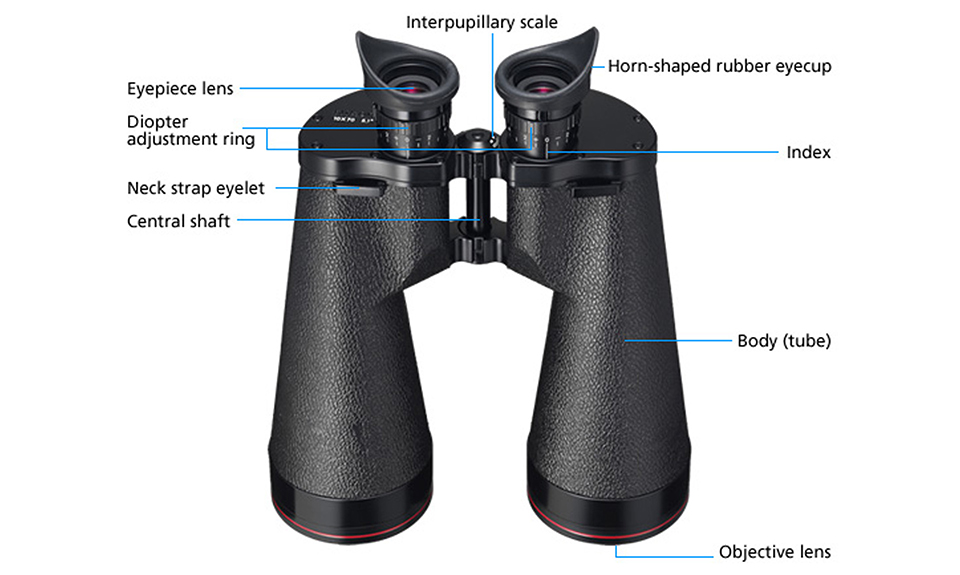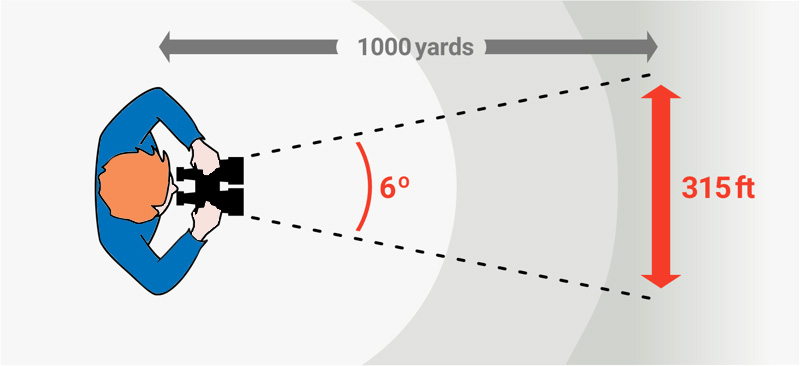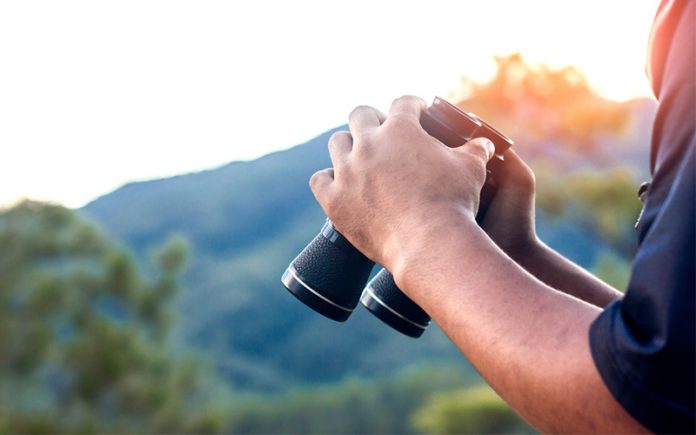Device like binoculars often doesn’t come with proper operating instruction. You’re out in the field with your pair of hunting binoculars and you notice its focus isn’t working. This can happen if the binocular optics are misaligned and as a result, you don’t get to focus on it like you used to. You might also notice black borders while looking through the lenses. You don’t have to worry much about these issues since we’ll talk about how to adjust binoculars in this article.
Common Binocular Adjustments
You need to know how to adjust binoculars correctly to make it usable in the field. When you’re trying to watch an object from far away, you have to calibrate your binocular according to your eyes. If you know how to adjust binoculars, you can easily adjust 4 essential parts that often require adjustments:
- Eyecup
- Center Focus
- Hinge
- Diopter

Adjusting the Eyecup
Eyecups are there to provide comfort for your eyes. Whether you’re a glass-wearer or not, you’ll get the maximum eye relief with eyecups. Eyecups are part of the eyepiece and there are several eyecup types:
- Fold up or down
- Twist up or down
- Wrap around
If you’ve purchased your binocular after extensive research, you already know that most of the modern-day binoculars come with eyecups that are plastic-made and only a few of them are made from actual metal. Eyecups come with a rubber covering for longevity and comfort around the eyes, brows, and skin.
How to Adjust Fold Eyecups?
Although there are only a few models that come with this style of eyecups, some hunters still have a preference for this old-school method. You can adjust the fold eyecups by following the next section.

1. For Glass-Wearers
If you’re wondering how to adjust binoculars with glasses, follow these steps:
- Fold the eyecups down
- Make sure you’ve kept the eyecups and the ocular lens as close to each other as possible
- You’ll now get a good field of view while you’re wearing glasses and watching through the ocular lens
2. For Non-Glass Wearers
- Fold up the eyecups
- Keep the eyecups and the ocular lens separated, or at a distance from each other
- You can now watch the field of view clearly with comfort and without getting any image aberration
How to Adjust Twist Eyecups?
This is the modern style of eyecups and users find it very convenient. You don’t need to push your eyes too much to get the correct relief with these eyecups. You can adjust them with this direction:
- Rotate the eyecup in a counter-clockwise motion, so you can take them away and out of the ocular lens
- If you have multi-position eyecups, you can hear a sound while you bring out the eyecup
- In fully adjustable eyecup, stop twisting when you’ve reached your optimum vision level
- On the optimum vision level, lock the eyecups to make them stay in the place
- Don’t press the eyecups too hard if you’re a non-glass wearer since the eyecups can get readjusted and you’ll lose the focus
How to Adjust Wrap Eyecups?
This style of eyecups also goes by the names wrap around, winged and horn. These eyecups have a winged or contoured design that comes in contact with your eye sockets. These are not for the glass-wearers. Wrap around eyecups shelter the eyes and you get an improved focus since it locks down the naked peripheral vision of your eyes. You don’t need to adjust these binoculars too much and you can follow the instruction for adjusting twist eyecups.
Adjusting the Hinges
If you want to know how to adjust binoculars, you have got to know how to work around the hinges on the binoculars. Binoculars and monoculars are almost the same except for the hinges. Binocular hinges come in 2 styles: single and double. They dictate the design of the binocular. As the name suggests, the single hinge binoculars only have one hinge in the middle of the binocular bridge. The double hinge binoculars have hinges on both sides of the barrel. It’s true that hinges are there to make the binoculars compact in size but they also make the adjustment for the Interpupillary Distance (IPD).
The hinges are one of the most underlooked things. Many hunters don’t concern themselves about IPD and many think the binocular is at fault without adjusting the hinges. If you want to properly adjust the hinges for your IPD, follow these steps:
- Expand both of the barrels as far as they’re expendable. This distance is usually 76-80 mm
- Slowly contract the barrels until your eye sockets become aligned with the barrels
- You’ll see two circles through the binocular
- Keep contracting the barrels until the two circles merge into one
- If you bring in the barrels too close to each other, you’ll notice crescent shapes, shadows, and aberrations in the field of vision
- If you notice any of the disturbances, start expanding again
Adjusting the Focus
If you’re wondering how to adjust binoculars with double vision, you might have a focus issue on your binoculars. Focus on an unmoving object with your binocular at a 30-40 feet distance and if you see a blurry image, it’s time you adjusted the binocular. You can see a clear object and still adjust the focus to get a sharper image. Here is a step-by-step direction on how to focus binoculars correctly:
- Cover the binocular’s right lens with your palms. If you see a blurry image through the left lens, the focusing ring needs adjustment
- The wheel at the binocular’s center is the focusing ring. Rotate the wheel to the left and then to the right. Continue doing this until you get a clear image on the left lens
- After the left lens is done calibrating, remove your palms from the lens
- Now close the left eye so you can solely focus on the right eye. If you get a blurry image, it’s time for you to adjust the diopter
- You’ll find a wheel on your right eyepiece. This is the diopter. Rotate this wheel to the point where there’s a clear image of the object on the right eye
- Now, look through both of the binocular lenses. You’d find the object to be in focus
- Once you’ve perfectly calibrated the lenses, you wouldn’t need to change the settings again
- If the image is still unclear, check the diopter in the center
Adjusting the Diopter
The diopter is the control knob in your binocular and it’s there to make up for the differences between the visions of your eyes. Sometimes all your pair of binoculars needs is a little adjustment on the diopter. Here’s how to set binoculars by adjusting the diopter on your binocular:
- Set the diopter setting at zero or the center
- Cover the right barrel with a lens cap
- Look through the binoculars to take a look at an object that’s not too far and is still
- Don’t close one eye and look with another in this process. Keep both of your eyes open and use only one eye to look
- Make sure you’ve got the correct focus on the left eye and then move to adjust the diopter
- Check if the main focus wheel remains in the same position as you’ve set it
- Now cover the left eye and watch at the same object with the right eye
- Tune the right eye by turning the diopter setting on the right barrel. Continue doing this until you’re seeing the object at a really sharp focus
- Don’t touch the main focus wheel during this process
- When you’re able to watch the object in sharp focus through the right eye, take the lens’ cap off
- Look at the object with both of your eyes through both of the lenses
- You’ll get a perfectly tuned image on your binocular
There are some binoculars that come with an additional diopter adjustment on the center of the binocular. To adjust this diopter, follow the same instruction except turn the central diopter and not the one on the right barrel.
The binocular adjustments you just made will differ from the adjustments your friend will make. So, keep your pair of binoculars to yourself as giving it to others will call for these adjustments again. Now that you know how to adjust binoculars, adjust yours as many times as you want when you’re on the field. You can also buy high-end binoculars that come with setting lock functions. No matter which binoculars you go for, you’ll need to make these adjustments on them to calibrate for your eyes.










































